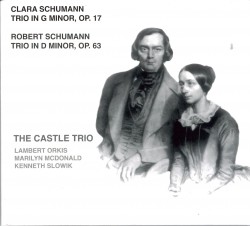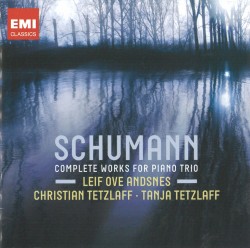
 Clara and Robert Schumann - Piano Trios
Clara and Robert Schumann - Piano Trios
Castle Trio
Friends of Music FOM 36-801 (www.smithsonian.org)
Robert Schumann - Complete works for Piano Trio
Leif Ove Andsnes; Christian Tetzlaff; Tanja Tetzlaff
EMI 0 94180 2
The American writer Catherine Drinker Bowen once referred to chamber music as “a conversation between friends.” I’ve long thought this a very apt description, and what better way to get ourselves in the mood for all the chamber music being heard at numerous festivals this summer than sampling these two recordings, featuring music by Robert and Clara Schumann? The first, on the Friends of Music label presents Clara’s only completed four-movement work, the Piano Trio Op.17, and her husband’s more familiar Piano Trio Op.63, performed by the Castle Trio. The second is a double disc featuring Schumann’s complete works for piano trio with Leif Ove Andsnes and Christian and Tanja Tetzlaff on EMI.
Clara Schumann’s Trio Op.17 and the Trio Op.63 by Robert were written within a year of each other, between 1846 and 1847, and both are now recognized as among the best of their output. Although Clara once described her trio as “effeminate and sentimental” there is no denying the fine craftsmanship displayed within. The American–based Castle Trio - Lambert Orkis, piano, Marilyn McDonald, violin, and Kenneth Slowik, cello – play with a finely-balanced precision and their exemplary interpretation is further enhanced by the decision to perform on early instruments, including an 1846 Streicher grand piano. To those used to modern-day chamber performances, the thinner, more transparent sound heard here may be a little disconcerting, but at the very least, the result is an accurate representation of how the music would have originally been heard.
The partnership among pianist Leif Ove Andsnes with violinist Christian Teztlaff and his sister, cellist Tanja Tetzlaff, is a not infrequent one, and their performance on this EMI recording is everything we’d expect from three outstanding players. Included in the set are the three piano trios, the Fantasiestücke Op.88, as well as the Six Etudes in Canonic Form Op.56, as arranged by Theodor Kirchner. Indeed, there is much to admire here – the playing is at times bold and impassioned, imbued with the true romantic spirit. Yet sections such as the second movement of the Piano Trio No.2 display a wonderful sense of intimacy, with the cello particularly warm and resonant. The four Fantasiestücke Op.88 are an attractive bonus, with the Marche finale bringing both the set and the collection to a buoyant and optimistic conclusion. In all, these are two fine additions to the catalogue; surely Robert and Clara would nod their heads in approval.



